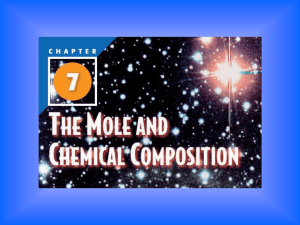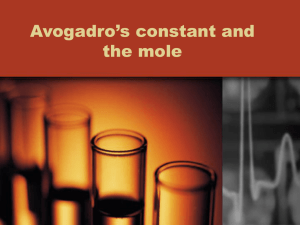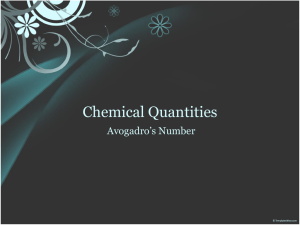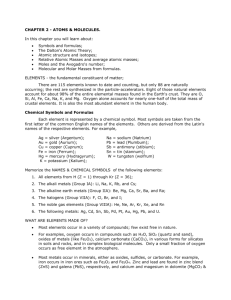The Mole & Avagadro - slider-dpchemistry-11
advertisement
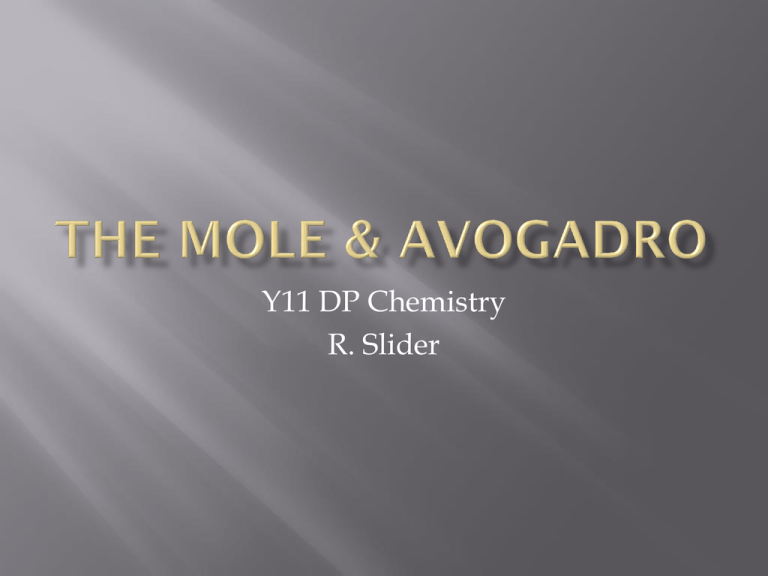
Y11 DP Chemistry R. Slider As you know, atoms are very, very small… Some single atom masses: Li: 1.15217 x 10-23 g O: 2.65659 x 10-23 g He: 6.64605 x 10-24 g U: 3.95233 x 10-22 g These masses are not terribly convenient to work with, so chemists work with relative masses. The relative atomic masses of all the elements are based on the mass of C-12 (1.99X10-22 g), the most abundant isotope on the Earth. In fact: Relative atomic mass (Ar) is defined as the mass of an element relative to 1/12 of the mass of an atom of the Carbon-12 isotope. These relative atomic masses are conveniently located on the Periodic Table and have no units since they are all relative. H: 1.01 P: 30.97 Br: 79.91 The mole is a unit used only in Chemistry that denotes the amount of substance (n). Since chemists had determined the relative atomic masses of the elements, it logically followed that 1.01g of H had the same number of atoms as 12.0g of C. And that same number of particles is equal to a mole of that substance. This is also a mole… The Mole is… The number equal to the number of carbon atoms in exactly 12 grams of pure 12C. (We once compared to H, the lightest element. Now we use C-12, the most abundant) 1 mole of anything = 6.022 1023 units of that thing (atoms, ions, molecules, grains of sand, etc.) 12g of C-12 contains 6.022x1023 atoms. This is known as Avogadro’s Number (NA or L) and is equivalent to 1 mole of carbon atoms. Avogadro’s number = 6.02x1023 = 1mole Notice that the mass of 1 mole of C-12 is the same value as the relative atomic mass for C-12 on the Periodic Table. In the same way, 1 mole of any element or compound is equivalent to its atomic, molecular or formula weight. We can now define the relative atomic masses from the periodic table as molar masses with the units g/mol. Substance Molar mass (g/mol) carbon 12 chlorine oxygen 35.5 16 water 18 Molar mass = mass of 1 mole of any substance From the previous example using C-12, we now have a mathematical relationship between mass and moles, which is: Mass of substance (g) Number of moles (n) = Molar mass (MM) (g/mol) Example: How many moles are in 25 g of CO? n CO = 25g CO/(12+16)g/mol = 0.89 moles We can also convert between moles and the number of atoms or molecules using Avogadro’s number Number of atoms/molecules = moles (n) x NA Example: How many atoms are there in a copper pipe that weighs 2.56g? n = 2.56/63.6 = 0.0403 moles number of Cu atoms = 0.0403 X 6.022X1023 = 2.43X1022 We can now use the mole concept to determine how much product to expect in a chemical reaction. Take the following example: 2Fe2O3(s) + 3C(s) 4Fe(l) + 3CO2(g) The coefficients in front of each species provide us with useful ratios that we can use to calculate expected masses of products in a chemical reaction. We previously said that these were ratios based on the numbers of atoms. However, with Avogadro’s number, we can now say that these are molar ratios. We say, 2 moles of iron (III) oxide react with 3 moles of carbon to produce 4 moles of iron and 3 moles of carbon dioxide gas. 2Fe2O3(s) + 3C(s) 4Fe(l) + 3CO2(g) Example: How many grams of iron will we expect if we react 12g of iron (III) oxide as in the above reaction, assuming neither reactant is in excess? Convert to moles 12g Fe2O3 X = 1 mol Fe2O3 159.8g Fe2O3 12 X 1 X 4 X 55.9 159.8 X 2 X 1 Convert to g of unknown Molar ratio X = 4 mol Fe 2 mol Fe2O3 8.4 g Fe X 55.9g Fe 1 mol Fe Molecular mass is the sum of the atomic masses of the atoms in a molecular formula. Example: The molecular mass of sucrose (table sugar) C12H22011 is calculated as: M.W. = (12XAC) + (22XAH) + (11XAO) M.W. = (12X12.0) + (22X1.01) + (11X16.0) = 342.2 Formula mass is the sum of the atomic masses in a compound which has no discreet molecules (e.g. ionic compounds). These describe the ratios of the atoms present (i.e. empirical formulas), but are calculated the same way as molecular masses. Example: The formula mass of calcium phosphate Ca3(PO4)2 is calculated as: F.W. = (3XACa) + (2XAP) + (8XAO) F.W. = (3X40.1) + (2X31.0) + (8X16.0) = 310.3 1. 2. 3. 4. 5. 6. 7. 8. What is the symbol for relative atomic mass? Write the relative atomic masses for O, Mg, S. Calculate the molecular mass of ethanol C2H5OH. Calculate the molar mass of copper(II) sulfate CuSO4. State the value and symbols of Avogadro’s Number. How many atoms are there in 3 moles of nitrogen atoms? 3 moles of ammonia? How many grams are there in 3 moles of nitrogen? 3 moles of ammonia? How many moles are there in 48g of water?


